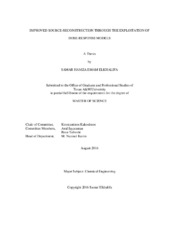| dc.description.abstract | The emergency actions following an accidental or intentional release of a hazardous material (HazMat) are strongly influenced by what is known of the HazMat event and its evolution (e.g. mass flowrate of the release, location of the release, and the duration of the release). Thus, the availability of such information in a timely and accurate manner is of great importance for emergency crews both on-site and in the areas in the proximity of the site. This information aids in predicting the fate of the release and mitigating the possible threats imposed by it on human health.
Characterizing the source of an atmospheric contaminant is typically regarded as an inverse problem, where one has to infer the source characteristics of the released HazMat from concentration or deposition measurements. The inverse solution is obtained by combining atmospheric dispersion models and concentration measurements in an optimal way, where dispersion models are used to produce concentration predictions in space and time using as input initial guesses of the source information. Furthermore, estimating the source parameters needed for atmospheric transport and dispersion modeling requires the application of deterministic and stochastic inversion techniques, such as the Bayesian frames employing Monte Carlo methods.
Locating the source and determining its release rate based on downwind concentration measurements, however, is only viable for some cases like industrial accidents, where measurement data from monitoring stations are typically obtained on-site. For other release cases, such as transport accidents or malevolent attacks, there is a lack of input data (i.e. immediate concentration measurements). Hence, there is a necessity to develop new approaches for real cases where this information is probably not available to the required extent or at all. This work presents the development, application and assessment of computational algorithms used in reconstructing the source characteristics following an accidental release of an airborne hazard. A promising methodology is the utilization of the resulting health symptoms from exposure as indirect input for emergency response systems. In this work, a total of six scenarios were constructed and analyzed in terms of their ability to reconstruct the source rate in addition to the source location. The results revealed that the source term information can be identified with good agreement with the true source parameters when using the new scheme. However, the complexity of the information used as input was reflected on the minimum requirement of input data needed to reconstruct the source term. The results also revealed the necessity to explore other sophisticated sampling and inversion techniques. | en |


